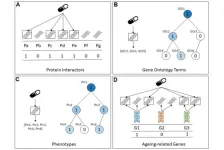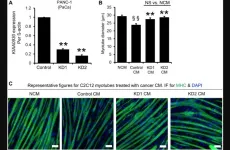(Press-News.org) New Haven, Conn. — A genetic analysis suggests that the servants and retainers who lived, worked, and died at Machu Picchu, the renowned 15th century Inca palace in southern Peru, were a diverse community representing many different ethnic groups from across the Inca empire.
The genomic data, described in a new study in Science Advances, is the first investigation of the genomic diversity of individuals buried at Machu Picchu and adjacent places around Cusco, the Inca capital. It builds upon previous archeological and bio-archaeological research, including a 2021 Yale-led study which found that Machu Picchu (AD 1420-1530) is older than was previously believed.
“The DNA analysis not only confirms the historical accounts that retainers were drawn from many different ethnic groups under Inca control, but it also demonstrates a much greater diversity of origins than had been suspected with individuals being brought from the entire empire,” said archaeologist Richard Burger, the Charles J. MacCurdy Professor of Anthropology in Yale’s Faculty of Arts and Sciences and lead researcher for the Machu Picchu project.
“Our analyses show that the population at Machu Picchu was highly heterogenous, with individuals exhibiting genetic ancestries associated with groups from regions throughout the Inca empire including the coast, highlands, and Amazonia,” Burger said.
Researchers from Yale, Universidad Nacional de San Antonio Abad del Cusco (UNSAAC), the University of California-Santa Cruz (UCSC), Tulane University, the Max Planck Institute for Evolutionary Anthropology, and other institutions conducted the study, under an agreement to return artifacts and human remains from the Hiram Bingham collection back to Cusco for exhibition, conservation, and study.
Machu Picchu is perhaps the most famous archeological site in the Western Hemisphere. Prior to the COVID-19 pandemic, more than a million visitors toured the site. Yet until quite recently, little was known about its inhabitants.
Scholars now believe Machu Picchu was a royal estate connected to the lineage of Pachacuti, the emperor credited with establishing the Inca empire. Royals resided at these estates seasonally, but a retinue of servants and retainers, known as yanacona, was left behind to take care of the facilities. Yanacona, who were brought to the estate from conquered lands, were believed to be privileged compared to the general population.
For the new study, researchers generated DNA data for 34 individuals buried at Machu Picchu who were believed to be retainers or attendants assigned to serve the Inca royal family, as well as 34 individuals from Cusco for comparative purposes.
“An unexpected result was the finding that many of the retainers were of Amazonian origin and about a third of them have DNA reflecting significant amounts of Amazonian ancestry,” said lead author Lucy Salazar, a research associate in Yale’s Department of Anthropology. “At least two zones within the Amazonian region are represented.”
Another unexpected result, the researchers said, was that many of the individuals had mixed ancestries, often from regions distant from each other. The researchers said this suggests individuals at Machu Picchu were selecting mates from other genetic groups, producing a diverse population unlike those found in agricultural villages.
“This study does not focus on the life of ‘royals’ or political elites, but on the life of those that were brought to Machu Picchu to serve the nobility that lived there and operated the place,” said co-corresponding author Lars Fehren-Schmitz, a professor at UC-SC and a former Yale post-doctoral researcher. “Thus, it gives us a unique insight into the life of a highly diverse community of individuals and their families who were subject to Inca forced relocation and resettlement policies, a group usually referred to as retainers or yanacona.”
Co-corresponding author Jason Nesbitt, a former Yale Ph.D. student who is now an associate professor at Tulane, noted that few of the individuals buried at Machu Picchu were from the Inca heartland of the Cuzco Valley or the adjacent Lake Titicaca region. He also said the four cemetery areas at Machu Picchu were not organized by genomic origin. Even the individuals buried in a single burial cave represented diverse genomic backgrounds.
“These results suggest that Machu Picchu was a cosmopolitan community in which people of different backgrounds lived, mated, and were interred together,” Burger said.
END
DNA analysis offers new insights into diverse community at Machu Picchu
2023-07-26
ELSE PRESS RELEASES FROM THIS DATE:
Lost metabolic fitness of CAR NK cells is key mechanism of tumor resistance
2023-07-26
A new study led by researchers at The University of Texas MD Anderson Cancer Center discovered loss of metabolic fitness in chimeric antigen receptor (CAR) natural killer (NK) cells is a critical mechanism of resistance, with infused cells gradually losing the ability to compete with tumor cells for nutrients, leading to tumor relapse.
The study, published today in Science Advances, demonstrates that engineering CAR NK cells to express interleukin-15 (IL-15) enhances the cells’ metabolic fitness and provides a longer-lasting ...
Researchers develop machine learning models that could improve suicide-risk prediction among children
2023-07-26
A new study from UCLA Health researchers finds that the typical ways health systems store and track data on children receiving emergency care miss a sizable portion of those who are having self-injurious thoughts or behaviors. The researchers also found that several machine learning models they designed were significantly better at identifying those children at risk of self-harm.
Amid a nationwide youth mental health crisis, mental health providers are trying to improve their understanding of which children are at-risk of suicide or self-harm so providers can intervene earlier. However, health systems often ...
DOE announces $33 million to advance energy research across America
2023-07-26
WASHINGTON, D.C. — The U.S. Department of Energy (DOE) today announced $33 million to support 14 clean-energy research projects as part of a program to ensure the Department’s research funding is reaching pockets of the country that traditionally have received disproportionally low amounts of Federal scientific funding. The projects will cover a range of topics—including grid integration, renewable solar and wind energy, and advanced manufacturing. Today’s funding will help ensure all regions of the country share in the ownership of priority research that advances science and addresses energy ...
Predicting lifespan-extending chemical compounds for C. elegans with machine learning
2023-07-26
“We created datasets for predicting whether or not a compound extends the lifespan of C. elegans [...]”
BUFFALO, NY- July 26, 2023 – A new research paper was published in Aging (listed by MEDLINE/PubMed as "Aging (Albany NY)" and "Aging-US" by Web of Science) Volume 15, Issue 13, entitled, “Predicting lifespan-extending chemical compounds for C. elegans with machine learning and biologically interpretable features.”
Recently, there has been a growing interest in the development of pharmacological interventions targeting ...
KIAA0930: A cachexic phenotype inducer in cancer cells
2023-07-26
“We believe that KIAA0930 would be a novel cachexia therapeutic target.”
BUFFALO, NY- July 26, 2023 – A new research paper was published in Oncotarget's Volume 14 on July 20, 2023, entitled, “The uncharacterized transcript KIAA0930 confers a cachexic phenotype on cancer cells.”
Patients with cancer cachexia have a poor prognosis and impaired quality of life. Numerous studies using preclinical models have shown that inflammatory cytokines play an important role in the development of cancer cachexia; however, no clinical trial targeting cytokines has been successful. Therefore, ...
Lifespan of ageing science’s model organism driven by reproductive self-destruction
2023-07-26
The lifespan of a small roundworm that has been used as a key model organism in ageing research is limited by how it self-sacrifices to feed its young, finds a new study led by UCL researchers.
The authors of the new Nature Communications paper say their findings raise questions about how well insights from the Caenorhabditis elegans (C. elegans) worm can be translated to human ageing advances.
C. elegans is widely used as a laboratory animal, and has been central to ageing research for 40 years thanks to discoveries of genes that can be supressed to produce up to a tenfold increase in ...
A study outlines the optimal strategy for accelerating the energy transition in China
2023-07-26
China has set itself the goal of reaching its peak of carbon dioxide emissions in 2030 and thereafter to reduce emissions to reach carbon neutrality by 2060. To achieve this, it needs to increase photovoltaic (PV) and wind power to 10-15 petawatt hours (PWh) by 2060.
However, according to historical installation rates and a recent high-resolution energy-system-model and forecasts based on China's 14th Five-Year Energy Development Programme (CFEDP), the capacity of China for producing non-fossil-fuel energy will reach a maximum of only 9.5 PWh per year by 2060.
Now, an international study with the participation ...
How eavesdropping viruses battle it out to infect us
2023-07-26
Viruses, like movie villains, operate in one of two ways: chill or kill.
They can lay low, quietly infiltrating the body’s defenses, or go on the attack, exploding out of hiding and firing in all directions. Viral attacks are almost always suicide missions, ripping apart the cell that the virus has been depending on. The attack can only succeed if enough other healthy cells are around to infect. If the barrage of viral particles hits nothing, the virus cannot sustain itself. It doesn’t die, since viruses aren’t technically alive, but it ceases to function.
So for a virus, the key challenge is deciding when to flip from chill mode into kill mode.
Four years ago, Princeton ...
Unraveling a protein that may inspire a new biotechnology tool
2023-07-26
COLUMBUS, Ohio – Scientists have unraveled the step-by-step activation process of a protein with a deep evolutionary history in all domains of life, opening the door to harnessing its functions for use as a biotechnology tool.
The protein belongs to the “superfamily” of Argonaute proteins, which previous research has suggested to be involved in gene silencing, a fundamental process known as RNA interference.
These proteins are well-characterized in eukaryotes – the plants, fungi, animals, humans and other life forms with cells that have a defined ...
Study: Insect protein slows weight gain, boosts health status in obese mice
2023-07-26
URBANA, Ill. — As the global population grows under a changing climate, the urgency to find sustainable protein sources is greater than ever. Plant-based “meat” and “dairy” products may be popular, but they’re not the only environmentally friendly meat alternatives.
A new study in mice from the University of Illinois Urbana-Champaign suggests replacing traditional protein sources with mealworms in high-fat diets could slow weight gain, improve immune response, reduce inflammation, enhance energy metabolism, and ...



